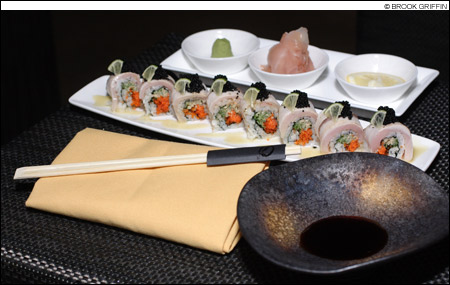The old thrill at the original Oishii restaurant in Chestnut Hill was to grab one of about nine seats and watch Ting San, a Nobu-level master and innovator, make unusual sushi for you. Now he has parlayed that cult success into an expensive South End assault on the highest reaches of Japanese food in the US, at admittedly New York prices. It’s a huge gamble, but the new Oishii is holding all the culinary cards. The only drawback right now is that the dining rooms are somewhat uncomfortable, especially to the ears. Someone persuaded Ting San that fairly simple, bouncy, ugly techno is what a slick-looking lounge should sound like. It may be so, but it’s hard to think of another chef who has permitted such good food to appear with such dismal fanfare.

ROLL WITH IT: Among other great choices, the makimoto at Oishii Boston is excellent. |
And what food it is! We began with a complimentary bit of squid salad on a Chinese soup spoon, and it’s a supreme mouthful: slightly chewy squid in a bright, herbal sesame-soy dressing. Next up was a good but familiar order of edamame ($6), fresh green soybeans in the salty pods, served in a no-handle teacup. Then, sashimis of three types of tuna ($4/piece): kampachi, hamachi, and albacore. In that order, they were rich (and picked up with tiny slices of Japanese lime), a bit leaner, and meltingly rich with extra layers of flavor. Tasting three tunas together brought out nuances of freshness and complexity that raw seafood doesn’t always have. It’s clear that Oishii is both attuned to the New England tuna season in progress and is purchasing the best airmail products on the market.
A second flight of sashimis brought a special on Japanese matsutake pine mushrooms ($6/each). I’ve picked a related species on Cape Cod and in Vermont. But these were petite, caught at the densest button stage, and very lightly grilled to bring out the aroma. They are tremendously prestigious and expensive in Japan, and rarely — if ever — featured on a Boston menu. Still, I prefer the spicy aroma of the local cousins.
We also tried two kinds of broiled eel: fresh ($4) and salt-water ($4.50). The former is the rich-flavored eel popular at many sushi bars. The latter is more subtly flavored: still rich, but more like boiled fish — an unusual treat.
Then there is the chef’s creation: seared toro sandwiches ($20). These were meltingly rich pieces of bluefin belly tuna — think foie gras with a very slight flavor of the sea, sandwiched between square “potato chips” made from rice, and decorated with a bit of gold leaf. Richness modulates into another key with an order of black pork gyoza ($8), six of the plumpest, thin-skinned, delicious Peking ravioli ever, made from the meat of heirloom Black Berkshire pigs. It’s followed by an order of grilled black cod ($18), the same fish we call sable and enjoy smoked in a deli. In Japan, sable makes perfect bar food. It’s incredibly rich whitefish, broiled fresh with a sweet miso glaze and a savory, caramelized skin. One of these and a couple makimono might make a light dinner for two.
Speaking of makimono, Ting San has trained his staff to roll them thinner and has developed several new combinations. “The Maki” ($23) most resembles the old ones from Chestnut Hill, with eight pieces filled with toro and pickle, topped with a spicy red sauce and microtome slice of jalapeño for kick. Kobe beef with red-wine-poached pear ($30) is another astonishing combination. The beef is rolled around rice and vegetable, and topped with a perfect cube of pear and a micro chive. Each bite features flavors of crunchy fruit and tender beef in an eternal yin-yang of flavor and texture. A maki of seared hamachi and sudachi limes ($23) allowed us to focus on the tart flavor of Japanese limes, intense in flavor rather than acidity.
Oishii has a menu of “entrées,” from which we ordered pan-seared halibut ($32). It came on a large plate, vertical in that a nice piece of halibut was mounted on a raft of grilled asparagus with a thin potato-lace fried wafer. Since that’s really not enough starch, it came with a teacup of sticky, fragrant Japanese rice.
Oishii has a lengthy list of domestic and imported sake, but I went for the regular wine list. Although it starts at $30 and climbs rapidly, it’s well selected for the food, with a lot of Pacific Northwest wines that seem made for fusion dishes. However, you needn’t go higher than the 2005 Hope verdelho from Australia ($30), a dry but fruity Iberian grape, with enough spice to match sushi and almost enough acidity to cut it. Oishii will also let you bring your own wine and will serve it for a corkage fee.